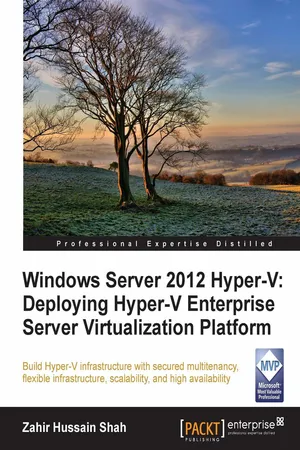![]()
Windows Server 2012 Hyper-V: Deploying Hyper-V Enterprise Server Virtualization Platform
![]()
Table of Contents
Windows Server 2012 Hyper-V: Deploying Hyper-V Enterprise Server Virtualization Platform
Credits
About the Author
About the Reviewers
www.PacktPub.com
Support files, eBooks, discount offers and more
Why Subscribe?
Free Access for Packt account holders
Instant Updates on New Packt Books
Preface
What this book covers
What you need for this book
Who this book is for
Conventions
Reader feedback
Customer support
Errata
Piracy
Questions
Introduction
What is virtualization?
Why virtualization?
Types of virtualization
Server virtualization
Network virtualization
Storage virtualization
Server consolidation
Cloud computing
1. Getting to Know Microsoft Hyper-V
Introducing Hyper-V
Hyper-V deployment scenario
Server consolidation
Physical-to-virtual and virtual-to-virtual conversions
Research and development
Business continuity and disaster recovery
Cloud computing
Hyper-V architecture
Hypervisor
Type 1 (bare metal) hypervisors
Type 2 (hosted) hypervisors
Monolithic hypervisors
Microkernel hypervisors
Insight into Hyper-V architecture
Parent partition
Child partition
Understanding Hyper-V parent partition
Hyper-V Virtual Machine Management Service
Virtual devices
Core devices (emulated devices)
Core devices (synthetic devices)
Plugin devices
Virtual machine bus
Features of Hyper-V
Hyper-V automation with PowerShell
Hyper-V dynamic memory improvements
Improved network virtualization and multitenancy
Hyper-V data offloading improvements
Hyper-V virtual machine replication
Resource metering for Hyper-V virtual workloads
Hyper-V support for large-sector disks
Virtual Fibre Channel for fabric connectivity
New virtual hard disk format
NIC teaming for host and guest machines
Hyper-V virtual switch improvements
Scalable virtualization infrastructure
Live storage migration
Hyper-V support for SMB
Hardware requirements
Processor
Storage
Disk types
SATA disks
SAS disks
Fibre Channel disks
Memory
Networking
Software requirements
Operating system version
Memory
Disk space
Physical server's paging file requirements
Guest virtual machine's paging file requirements
Hyper-V version comparison
Hyper-V Windows Server 2012 guest VM support
Guest server operating systems
Guest client operating systems
Licensing
Summary
2. Planning, Designing, and Implementing Microsoft Hyper-V
Planning and designing Hyper-V infrastructure
Microsoft Solution Accelerators
Hyper-V infrastructure planning and designing solution accelerators
Upgrading legacy Hyper-V servers to Windows Server 2012
Upgrading Hyper-V standalone server
Upgrading Hyper-V cluster servers
Installing Hyper-V server role
Hyper-V server role installation requirements
Installing a fresh Hyper-V server
Server Manager
Installing Hyper-V role using Server Manager
Installing Hyper-V with Windows Server Core
Introducing Windows Server Core
Benefits of using Windows Server Core Edition
Installing and managing Windows Server Core
Configuring and managing Windows Server 2012 Server Core
Adding Hyper-V server role for Windows Server Core
Configuring basic settings for Hyper-V server role
Hyper-V settings
Virtual hard disks
Virtual machines
Physical GPUs
NUMA spanning
Live migrations
Storage migrations
Replication configuration
Virtual Switch Manager
Creating a virtual machine
Memory
Processor
Hard drive
Summary
3. Setting Up Hyper-V Replication
Introducing Hyper-V replication
Hyper-V Replica terminologies
Software requirements
Hardware requirements
Deployment scenario for Hyper-V Replica
Head office and branch office
Geographically dispersed datacenters
Managed services and hosting provider
Cloud service provider
Technical overview of the Hyper-V Replica feature
Replication Engine
Change tracking
Network module
Hyper-V Replica broker
Hyper-V Replica best practices
Security
Networking
Storage
Setting up Hyper-V Replica
Enabling Hyper-V replication
Enabling Hyper-V replication for standalone Hyper-V servers
Enabling Hyper-V replication for clustered Hyper-V servers
Configuring Hyper-V Replica
Configuring Hyper-V Replica for standalone virtual machines
Configuring Hyper-V Replica for a highly available virtual machine using Failover Cluster Manager
Hyper-V Failover Replication broker architecture
Configuring Hyper-V Replica for reverse replication
Monitoring Hyper-V Replica environment
Hyper-V virtual machine replication health checking
Performance monitoring for Hyper-V Replica virtual machines
Reviewing Microsoft Hyper-V VMMS logs for Hyper-V Replica
Summary
4. Understanding Hyper-V Networking
Hyper-V virtual switch technical overview
Windows Server 2012 – a cloud-ready platform
Improved Hyper-V virtual network switch
Load balancing and failover (NIC teaming)
Quality of service and bandwidth management
Single root I/O
Extensible Hyper-V virtual switch
ARP/ND poisoning (spoofing) protection
DHCP guard
Port access control lists (ACLs)
Trunk mode to a VM
Network traffic monitoring
Configuring the Hyper-V extensible virtual network switch
Configuring the Hyper-V host virtual network switch
Types of Hyper-V virtual network switches
External
Internal
Private
Configuring Hyper-V virtual machine network settings
Virtual network adapter types
Synthetic network adapter
Legacy network adapter
Configuring advanced network settings
Bandwidth management
Hardware acceleration
Virtual machine queue
IPSEC task offloading
Single root I/O virtualization
Failover TCP/IP
Advanced features of the virtual machine network adapter
MAC address spoofing
DHCP guard
Router guard
Port mirroring
NIC teaming
Implementing NIC teaming for Hyper-V host and guest
Native OS NIC teaming feature – the most awaited feature
NIC teaming requirements
NIC teaming architectural consideration
Configuring NIC teaming for the Hyper-V host
NIC teaming advanced settings
NIC teaming mode
Switch independent
Switch dependent
Static teaming
Dynamic teaming
Load-balancing mechanisms
Address hash
Hyper-V port
Configuring NIC teaming for Hyper-V guest virtual machines
Summary
5. A New World of Hyper-V Automation with PowerShell
Introduction to PowerShell
Technical overview
Cmdlets
Cmdlets pipelining
PowerShell scripting
PowerShell Version 3.0 overview
Insight into Windows Server 2012 PowerShell (3.0)
PowerShell OS support
System requirements
Windows Management Instrumentation 3.0
Common Language Runtime 4.0
.NET Framework
WS-Management 3.0
Installing PowerShell 3.0
Managing Windows Server 2012 Hyper-V with PowerShell 3.0
PowerShell usage scenarios for Hyper-V management and automation
Research and development environments
Virtualized datacenter management
Cloud management and automation
Windows PowerShell 3.0 capabilities for Hyper-V
Example 1 – creating a new virtual machine
Example 2 – creating a new virtual network switch
Example 3 – configuring and attaching a virtual network switch to a virtual machine
Example 4 – shutting down all virtual machines
Example 5 –...
